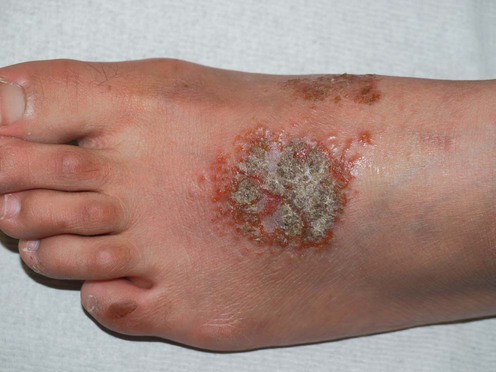Moore MM, Elpern J, Carter DJ. Arch Dermatol 2004; 140: 215–17.
Discoid eczema
Nummular eczema

Management strategy
 Other disorders may need to be excluded, especially mycoses, psoriasis, Bowen’s disease, mycosis fungoides, sarcoidosis.
Other disorders may need to be excluded, especially mycoses, psoriasis, Bowen’s disease, mycosis fungoides, sarcoidosis.
 A medication and alcohol history should be taken.
A medication and alcohol history should be taken.
 Patch testing may be useful; metals and medicaments (such as fusidic acid, lanolin, neomycin, and cetosteryl alcohol) are most implicated.
Patch testing may be useful; metals and medicaments (such as fusidic acid, lanolin, neomycin, and cetosteryl alcohol) are most implicated.
 The management of discoid eczema is generally similar to that of other eczemas; emollients appear to be helpful owing to the link with dry skin.
The management of discoid eczema is generally similar to that of other eczemas; emollients appear to be helpful owing to the link with dry skin.
 The mainstay of treatment is topical corticosteroids. Severe itch in discoid eczema usually dictates that strong agents are applied; this is safe because the individual lesions are small, rarely affect thin skin sites such as the face or flexures, and usually respond to this approach. Chronic lichenified lesions may respond better to steroid impregnated tapes or by using a potent steroid with hydrocolloid dressing occlusion.
The mainstay of treatment is topical corticosteroids. Severe itch in discoid eczema usually dictates that strong agents are applied; this is safe because the individual lesions are small, rarely affect thin skin sites such as the face or flexures, and usually respond to this approach. Chronic lichenified lesions may respond better to steroid impregnated tapes or by using a potent steroid with hydrocolloid dressing occlusion.
 Calcineurin antagonists have been used successfully both as monotherapy and in combination with topical steroids, but trials specifically looking at efficacy in discoid eczema exclusively, rather than atopic eczema generally, are lacking.
Calcineurin antagonists have been used successfully both as monotherapy and in combination with topical steroids, but trials specifically looking at efficacy in discoid eczema exclusively, rather than atopic eczema generally, are lacking.
 If weeping is present, the use of soaks (with, e.g., 1 in 10 000 potassium permanganate solution) will help dry lesions up and prevent lesions sticking to clothes or dressings.
If weeping is present, the use of soaks (with, e.g., 1 in 10 000 potassium permanganate solution) will help dry lesions up and prevent lesions sticking to clothes or dressings.
 Secondary impetigenization particularly in the exudative phase is common, and combining a topical antibiotic or antiseptic, or the use of an oral anti-staphylococcal antibiotic helps.
Secondary impetigenization particularly in the exudative phase is common, and combining a topical antibiotic or antiseptic, or the use of an oral anti-staphylococcal antibiotic helps.
 Tar-based treatments and impregnated bandages to minimize the effects of scratching may help.
Tar-based treatments and impregnated bandages to minimize the effects of scratching may help.
 Sedating antihistamines before retiring will help nocturnal scratching and minimize excoriation.
Sedating antihistamines before retiring will help nocturnal scratching and minimize excoriation.
 Systemic immunosuppressive therapies are usually not required.
Systemic immunosuppressive therapies are usually not required.
Specific investigations
Severe, generalized nummular eczema secondary to interferon alpha-2b plus ribavirin combination therapy in a patient with chronic hepatitis C virus infection.
![]()
Stay updated, free articles. Join our Telegram channel

Full access? Get Clinical Tree









